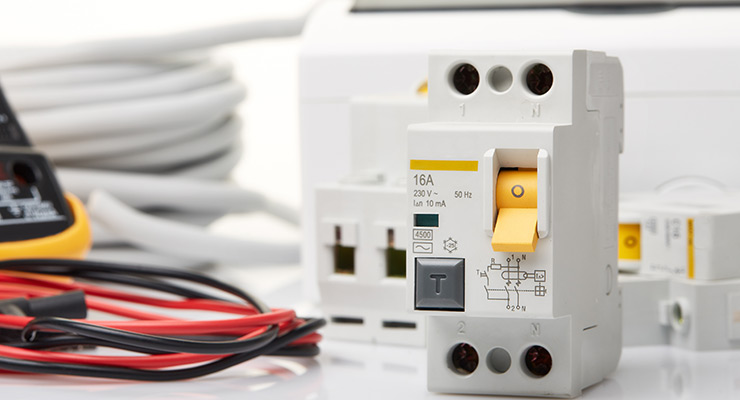Fast read
An Arc Fault Detection Device (AFDD) is crucial for preventing electrical fires. It detects dangerous arc faults caused by loose connections, damaged insulation, or worn contacts, cutting off power to prevent fires. Arc faults generate heat, which can deteriorate wire insulation and trigger fires.
Although more common in the U.S. due to their 110V systems, arc faults pose a risk globally. AFDDs use microprocessor technology to monitor electrical patterns and stop power when irregularities are detected. While not mandatory everywhere, installing AFDDs enhances safety, protecting lives and property from fire risks.
What is an Arc Fault Detection Device?
An arc fault is a high-power discharge of electricity between two or more conductors. This discharge generates heat, which can break down the wire’s insulation and trigger an electrical fire. Typically caused by loose or faulty connections, arc faults begin with low-level arcing, followed by sparking. When the heat becomes excessive, the insulation breaks down, potentially leading to fires.
The significance of addressing arc faults cannot be overstated. According to the Electrical Safety Foundation International (ESFI), arc faults start over 35,000 home fires annually in the U.S., causing more than 1,130 injuries, 500 deaths, and $1.4 billion in property damage. Although these statistics are specific to the United States, where 110V systems with higher current flow are used, the risk is relevant worldwide.
The Emergence of Arc Fault Detection Devices
Arc fault detection devices (AFDDs), also known as Arc Fault Circuit Interrupters (AFCIs), were first introduced commercially in 1997. The U.S. mandated these devices for bedroom receptacle electrical circuits in 1999 and expanded the requirement to almost every room by 2008. Since then, efforts have been made to develop standards for AFDDs in 220-240V countries, including Australia.
In Australia, the prevalence of faulty and cheap DC switches in solar systems has highlighted the need for arc fault protection. AFDDs are now being installed in all new solar systems to enhance safety.
What Causes Arc Faults?
Arc faults occur when electrical current jumps the gap between two conductive materials. Common causes include:
- Worn Contacts: Over time, contacts in electrical equipment can wear down, creating gaps that allow arcs to form.
- Damaged Insulation: Insulation can degrade due to heat, age, or physical damage, exposing conductive materials.
- Cable Breaks: Physical breaks or cuts in cables can create paths for arcing.
- Loose Connections: Poorly connected wires can move and create arcs.
Fire Statistics and Arc Faults
Despite advancements in fire safety, electrical faults remain a significant cause of residential fires. In 2017-18, the UK recorded 74,118 primary fires, with 13,070 attributed to electrical distribution or appliance faults. While AFDDs may not prevent all electrical fires, their widespread use could significantly reduce the number of incidents.

How Arc Fault Detection Devices Work
AFDDs are protective devices installed in consumer units to detect and mitigate arc faults. These devices use microprocessor technology to analyze the electrical waveform and identify unusual patterns indicative of an arc fault. Upon detection, the AFDD cuts off power to the affected circuit, preventing potential fires.
Similar to Residual Current Circuit Breakers (RCCBs) or Residual Current Breakers with Overcurrent Protection (RCBOs), AFDDs often include a test button. This allows users to verify the device’s mechanical operation, ensuring it functions correctly.
Do You Need to Install Arc Fault Detection Devices?
The decision to install AFDDs should be guided by an electrical designer or installer. While current regulations, such as the IET Wiring Regulations BS 7671:2018, recommend AFDD installation, it is not mandatory. Customers should weigh the risks and safety benefits against the cost of installation.
AFDDs are particularly advisable in high-risk environments, such as:
- Homes with Sleeping Areas: Houses, hotels, and hostels where occupants are at greater risk if a fire breaks out while they sleep.
- Locations with Combustible Materials: Stores or workshops containing flammable materials.
- Buildings with Combustible Construction: Wooden buildings and structures with high fire propagation potential.
- Places Housing Irreplaceable Items: Museums, listed buildings, and properties with items of sentimental or historical value.
Insurance companies may also have policies regarding fire safety measures, potentially affecting payouts if AFDDs are not installed as recommended.
Do All Circuits Need AFDDs?
Not all circuits may require AFDDs. In some cases, protecting specific high-risk circuits might suffice. However, in buildings with high fire propagation risk, like timber-framed structures, it is advisable to protect the entire installation.
Cost of These Devices
The cost of AFDDs can be significant, with typical prices around $100 per device. A comprehensive consumer unit with RCBOs, circuit breakers, surge protection, and arc fault detection devices represents a considerable investment. However, considering the device’s potential to save lives and protect valuable property, the long-term benefits outweigh the initial costs.
Conclusion
Arc fault detection devices are crucial for enhancing electrical safety in homes and commercial buildings. By detecting and mitigating arc faults, these devices can prevent electrical fires, saving lives and reducing property damage. While not yet mandatory in all regions, their installation is a wise consideration for anyone looking to improve fire safety and protect their property.
In summary, understanding the role and importance of AFDDs can help you make informed decisions about electrical safety in your home or business. Investing in these devices can provide peace of mind and significantly reduce the risk of fire-related incidents.



